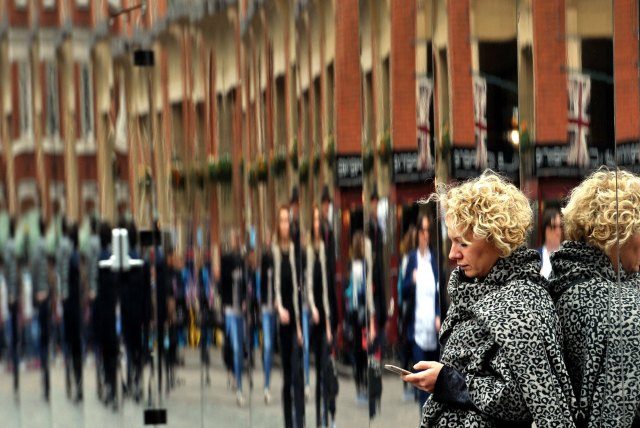Digital twin. Nick Ansell/PA Archive/PA Images

Whatever happened to cyberspace? According to Google Trends the term is now passé. But back in the day, inspired by films like Tron and The Matrix, we thought of the internet as a parallel dimension in the making.
Then the prosaic reality of Windows and FaceBook kicked-in, and we realised that the internet was basically just an electronic version of our filing cabinets and photo albums – useful or even addictive, but hardly a world of its own.
But that is changing fast. Piece-by-piece we are building a parallel world in truly remarkable detail. And it’s no game. For instance, you wouldn’t expect much mucking about in a German factory – but as an Economist report from a Siemens facility makes clear, virtual reality is being put to productive use:
“…there is another factory, a virtual version of the physical facility that resides within a computer system. This digital twin is identical in every respect and is used to design the control units, test them, simulate how to make them and program production machines. Once everything is humming along nicely, the digital twin hands over to the physical factory to begin making things for real.”
Using this technology, one can modify the digital twin to see how changes to its real world counterpart would work out. Assuming enough computing power, one could also fast-forward the simulation to predict what might happen to the original at a given point in the future – for instance, which machine parts might malfunction first.
Furthermore, components within each simulation could be copied and incorporated into other simulations:
“The spread of digital twins could shake up supply chains. For example, suppliers could be asked to submit a digital twin of their product so that it can be tested in a manufacturer’s virtual factory before an order is placed.”
Presumably, there must come a point at which the exchange of content merges the individual simulations into one giant simulation.
For the moment these digital twins are of objects – from simple products to complex machinery. But what about digital twins of real people?
In a feature for the Proceedings of the National Academy of Sciences, Mitchell Waldrop writes about the use of ‘agent-based models’ – computer simulations of human societies:
“These artificial societies contain thousands or even millions of subroutines, each representing individual people moving through virtual landscapes while behaving in more or less human ways. Modelers can simulate real-world geography and transportation networks; realistic populations that have the right distribution of ages, genders, and jobs; and details about who comes into contact with whom: ‘the entire social structure of households, hospitals, and workplaces’ says Ira Longini, a statistician and modeler at the University of Florida in Gainesville.”
Waldrop’s main focus is on the use of agent-based models to predict and combat the spread of highly infectious diseases like ebola. However, agent-based models are also being used closer to home – for instance, by the Bank of England:
“In November 2016, Andy Haldane, chief economist at the Bank of England, took his discipline to task for failing to anticipate major events, such as the financial collapse of 2007-2008: the economic analog of a global pandemic. A big part of the problem, he said, was that his colleagues typically modeled swings in the economy using equations that focused only on global factors such as interest rates, while ignoring… individual human differences and interactions. Instead, they should be building on decades of academic research that has produced agent-based models of issues such as innovation, inequality, and the stability of the financial system.”
The Bank has already developed two agent-based models – one for the housing market and one for the bond market.
As things stand, the sub-routines representing the individual humans within each model are fairly simple. After all, the purpose of such models is to predict broad outcomes at a population level. But what happens as programming techniques become more sophisticated – allowing the sub-routines to develop into digital twins of real people, informed by data pulled in from social media sites and public sector records?
In an agent-based model owned by a prospective employer, your digital twin would be like a walking, talking CV (or résumé) with a mind of its own (or, rather, the semblance of one). How would you like to have your virtual self tried-out in a simulated workplace? Or what about an agent-based model operated by a crime-fighting agency? What if your ‘twin’ starts misbehaving in one of those?
One would hope that that the predictive limitations of such models would be understood. But the real issue isn’t whether they should be believed, but whether they are believed.










Join the discussion
Join like minded readers that support our journalism by becoming a paid subscriber
To join the discussion in the comments, become a paid subscriber.
Join like minded readers that support our journalism, read unlimited articles and enjoy other subscriber-only benefits.
Subscribe